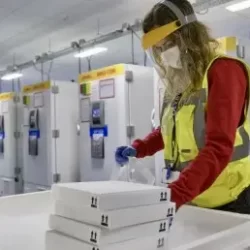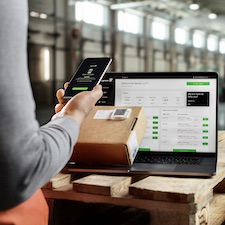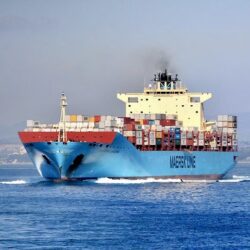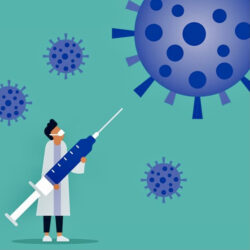DHL: ‘Vaccine and test-kit logistics would never have succeeded without standardization’

Despite all the supply chain disruptions, the distribution of COVID-19 vaccines and test kits in Europe and beyond has gone well. Logistics provider DHL, who was responsible for this operation, attributes the smooth-running of the operation to the use of GS1 standards such as the Global Trade Item Number (GTIN) and the Serial Shipping Container Code (SSCC). Peter Korte, Vice President Life Sciences & Healthcare Benelux & Denmark at DHL, comments: “We tried to give everyone insight into what was going on. Thanks to the use of GS1 barcodes, we succeeded in delivering on time and maintaining a good standard of quality.”
Logistics service providers are used to facing tough challenges, but the COVID-19 outbreak called for an extra pioneering approach from DHL. “The government initially asked us whether we could store 32 pallets containing test kits. That enabled us to demonstrate our willingness – and ability – to be adaptable,” says Korte. The first aircraft carrying the test kits landed just a few days after DHL had agreed to help out. “The 32 pallets rapidly increased to 9,000 pallets – and we’re still supplying all the test centres in the Netherlands to this day.”
Astronomical volumes
DHL takes care of the logistics for vaccine and test-kit distribution throughout the Netherlands, other European countries and elsewhere from a healthcare campus comprising almost 90,000m2. Korte: “One of our existing customers, a frontrunner in PCR testing, was the first company in the world to launch a rapid test. That led to astronomical volumes in the supply chain. From the campus in the Netherlands, we handle distribution for virtually all destinations worldwide, apart from the US.”
Preparing for the vaccines to arrive
The steps taken by DHL Supply Chain were largely a logical response to what the market needed, but not entirely. Korte explains that they first started preparing the logistics operation for the arrival of vaccines back in the summer of 2020: “For another of our customers, who also happens to be a vaccine producer, we worked out a detailed plan including how to pack the vaccines. We presented the plan to our board and received approval to invest in an ultralow-temperature freezer farm.”
Need for refrigerated storage and bigger power supply
That plan was further developed and implemented in the second half of 2020, resulting in the infrastructure for the refrigerated storage of vaccines. It was a mammoth task, according to Korte: “It wasn’t just a case of ordering it and installing it. We had to set up a link with the building management system in order to control the temperature, plus we needed a much bigger power supply. We also needed a system to extract the vapours from the dry ice.”
Reduced airfreight capacity
In order to secure buy-in from other stakeholders involved in the new vaccine and test-kit supply chain, DHL developed a white paper to provide tips for effective distribution. “We’re talking about 15,000 flights and 200,000 pallets carrying 10 billion vaccines. Many of those vaccines also have to be kept at a low temperature at all times. That makes it a complex supply chain, especially for third-world countries,” says Korte. The reduced airfreight capacity caused additional headaches. “It created a tsunami of cargo, not least because the vaccines had to be shipped to hundreds of thousands of different distribution points worldwide. It was only by working with standards as much as possible that we succeeded in delivering on time and maintaining a good quality level.”










